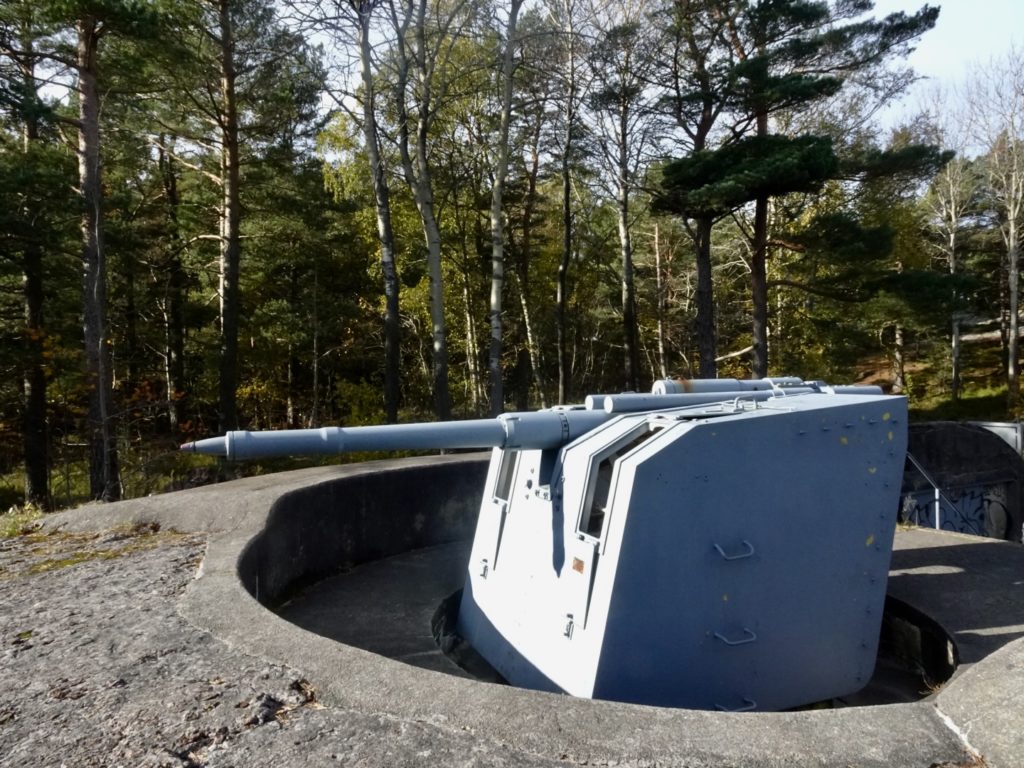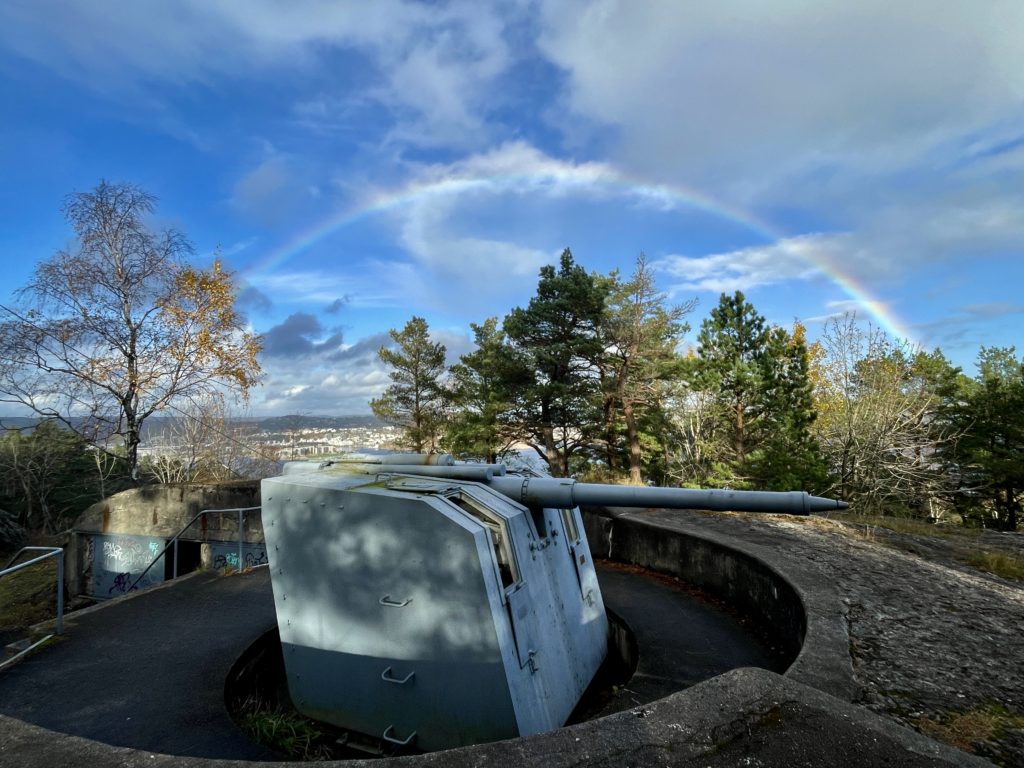When the facilities were closed down in 1872, the public was allowed access to the fortress area. At the end of the nineteenth century, the plans from 1888 – 1891 were implemented, with work on the battery on Gleodden being initiated in 1896 and completed in 1897. The implementation of the plans for Odderøya was only completed in 1904. The fortifications were named "Odderøen and Topdalsfjorden's fortifications," but when the facilities on Odderøya were finished, the name was changed to "Kristiansand fortifications.”
1641-1800
Odderøen battery. In 1667, two wooden redoubts were built on Nedreberget (Lasaretthøyden). This was the start of what, after further development, was named Odderøen Fæstning. The bombproof gunpowder tower was completed in 1700. The facility had space for 15 cannons. Along the outer edges of the mountain plateau was a continuous gray stone wall. The fortress was closed down in 1796 to make way for the planned quarantine station. Today, the height itself with the claimed buildings is protected by the National Antiquities.
Oversold battery was on Odderøya's highest plateau, built in the 1690s. The place was later named "Utkikk". The facility consisted of a pentagonal star redoubt and a gray stone powder tower. We know that King Fredrik IV inspected the facility in 1704. Stjerneskansen was destroyed by lightning sometime in the 1700s.
Southwest Battery was built in the 1690s and was located somewhat south of the current Odderøya lighthouse. It is uncertain whether cannons were deployed in this battery.
Northwest Battery, probably established around the year 1700 on Gamleberget (Kommandanthøyden). There is little information to be found about this battery.
1800-1890
Eastern Battery was established in 1807, near Kolerakirkegården, and mounted with six 18-pounder guns. Together with a corresponding battery on Galgebergtangen and Christiansholm fortress, a possible enemy was to be prevented from penetrating the eastern harbour. A rampart house and two "blended" ammunition houses were built in the battery. The battery was closed down in 1872. The area was later named "East camp". Today, at the outer edges of the battery area, you can see the fine rock settings that limited the area. You can also see walls, with an earthen embankment on top, which was the "blendering" that protected the ammunition houses from shelling. At the rear of the area, two particularly strong foundation walls, erected during the First World War, can be seen.

The mortar battery just south of "Utkikk" was established in 1807 with two 50 pound mortars and four 24 pound guns. Crew 24 artillerymen 48 infantrymen. In 1824 the gunnery was transferred to Søndre battery. The battery was set up again in 1849, then with four mortars. Discontinued in 1872.
Western Battery, built in 1808 at Gamleberget. Consisted of two lines, mounted with six 18-pounder guns and two 50-pounder mortars. Crew 48 artillerymen and 96 infantrymen. The battery gradually decayed and was not restored.
Second battery was built in 1812 at the far south of Odderøya and set up with six 18-pounder and four 8-pounder guns. The number and type of cannons have varied over the years. In 1838 the battery had 7 guns and a crew of 42 artillerymen and 84 infantrymen. In the 1840s, the battery was improved, two rampart houses were built and a piling structure with shooting holes and a banquette for back cover. In 1853, a bomb-proof gunpowder tower was built with space for 100 centners of gunpowder (one centner approx. 50 kg). The battery had one guard house which in 1904 was extended by 4 meters to the size the building has today.

Red guns at Søndre battery
1890-2000.
The major development of fortifications at Kristiansand took place between 1895 and 1905. The designation Kristiansand's fortifications, changed in 1937 to Kristiansand fortress. The construction works on Gleodden first started (1895) with 3 x 15 cm cannons Armstrong M 1897 and 2 x 6.5 cm cannons Hotchkiss M 1895. The cannons were fully assembled in 1897. The battery was manned in 1898. It took some time to get started with the development on Odderøya, but here a strong development was carried out with several batteries:
The howitzer battery had 4 24 cm howitzers St. Chamond M 1902, mounted on top of the island.
21cm battery with 2 pcs 21 cm guns St. Chamond M 1902, set up on the east side of the top. 6 pcs 15 cm guns Armstrong M 1897, divided with 2 guns on the South beach battery and the North battery.
Western Battery, The intermediate battery and Eastern Battery with 2 6.5 cm guns Hotchkiss M 1895 and 4 7.5 cm field guns M 1901. All modern equipment. Construction work began in 1901 and the guns were in place in 1904. This grouping of the gun equipment was retained until 1940. It was this equipment that we met the German attack with in 1940, but unfortunately not all the guns were manned. Virtually all the positions of these guns and the associated command posts are fully visible to this day.
Informative road signs have been set up and posters at most objects provide a brief historical description.
Norwegian plans to move the cannons to more forward positions were adopted in 1937, but they did not manage to implement them before the German attack in April 1940. In the summer of 1940, the Germans began to reorganize the coastal defenses around Kristiansand. First they moved 2 21 cm guns to Laksevika. In the autumn of the same year, they moved 3 15 cm cannons to Kjære on Flekkerøya and the last 3 from Odderøya to Randøya. The 15 cm battery on Gleodden was moved to Ålesund. Thus, only the howitzer battery and a barrage battery with 2 65 mm guns remained on Odderøya in mid-1941.
After the war, 2 units were set up in 1946/47 10.5 cm K331(f) cannons in the positions of the Middle Battery. The cannon was originally a field cannon, but rebuilt with a pedestal mount for coastal artillery purposes. It was equipped with binoculars as an aiming device, had a screw mechanism and split charge, explosive grenades and armor-piercing grenades. Range 12,000 m. In 1958, there was clearly a lot of wear and tear which made the demand for the replacement of the cannons urgent. It started later in 1958 and continued in 1960. The replacement was 2 cannons of type 10.5 cm SKC/32. A third cannon of the same type was mounted in the stand of cannon 1 in the old Eastern battery. The range of these cannons was about 15,000 meters, rate of fire about 12 shots per minute. The emplacements were modified, but the guns were still in open wells. The cannons, which were originally intended for anti-aircraft fire, came from Løvåshaugen in Bergen. They had a ship's shield and on Odderøya they also got an "umbrella stand" with a tarpaulin against the weather. Of these, we have today kept the 2 cannons that were mounted in the positions of the Intermediate Battery.
The battery was operational until 1994 when it was shut down and operators of the guns and the battery's fire control equipment were no longer trained.
The main task of the battery was to protect the minefield between Oksøy lighthouse and Grønningen lighthouse.
The battery had been supplied with new ammunition in the 80s and had the most modern fire line. The latter due to the presence of the Shooting School for the Coastal Artillery on the island. The school was responsible for the special training of officers for the Coastal Artillery.
Sources: (1) "Kristiansand's settlement and population in older times" by oblt Karl Leewy.
(2) "The cannons at Skagerak" by Jan E. Fjørtoft.
(3) "Kristiansand Fortifications History" by Colonel OM Calmeyer.
(4) "The naval defense at Agder" 2003 NTS












